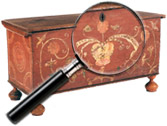|
|
Opus One
The Opus One project marked an important milestone in American winemaking. For the first time, a towering figure from the European side, Baron Philippe Rothschild, saw fit to enter into a collaborative venture with the leading California vintner, Robert Mondavi. This association gave a renewed luster to Napa Valley winemaking. The Opus One wines tend to be elegant and silky – they are not cumbersome.
Note courtesy of Skinner Inc.
Thomas Satterwhite Noble (1835-1907)
Born in Lexington, Kentucky, Thomas Noble studied art with George Peter Alexander Healy and Kentucky artist Oliver Frazer. In 1856 he traveled to Paris to study with the historical painter Thomas Couture who pronounced the young artist as “Made for a painter.” Returning home from Europe on the eve of the Civil War, Noble joined the Confederate Army despite his opposition to slavery. After the war, he opened a studio [...] Click here to continue reading.
August Norieri (New Orleans, 1860-1898)
The inspired career of the August Norieri was tragically ended by his untimely death in 1898 at the age of thirty-eight. Norieri’s paintings reflect his fascination with the waterways of New Orleans and the variety of boats that traversed them. The picturesque steamboats along with the hard working tugboats of the Mississippi River, the sailing boats on Lake Ponchartrain and the steam launch pleasure boats on Bayou St. John [...] Click here to continue reading.
William Edward Norton (1843-1916)
William Edward Norton grew up in Boston, studied at the Lowell Institute and later with George Inness. He went to sea as a teenager (his family owned ships) and his experiences there led him to favor marine subjects throughout his career.
In 1868, Norton went to Paris to continue his studies, and eventually settled in London. He exhibited regularly at the Royal Academy and at the Paris Salon. He returned [...] Click here to continue reading.
George Loftus Noyes (1864 to 1954)
A Boston school artist best known for his landscapes, George Loftus Noyes plein air paintings adopted the loose brushstrokes of the French Impressionists. Born in Ontario, Noyes moved to Cambridge, Massachusetts, as a child. He started taking painting lessons when he was fifteen from English artist George Bartlett at the Massachusetts Normal School, and had an apprenticeship at the New England Glass Company painting floral designs on glass. [...] Click here to continue reading.
The Women of The Brandywine – Violet Oakley (1874-1961)
The Brandywine Valley, which sweeps from southeasten Pennsylvania into northern Delaware, fostered a wealth of talent at the turn of the 20th century. Howard Pyle, known as “the Father of American Illustration” was beginning his own artistic movement and school in this rural area of the East Coast. Pyle’s romantic imagery in his work was passed on to his female students whom he taught with [...] Click here to continue reading.
Leonard Ochtman (1854-1934)
Born in Zonnemain, Holland, Leonard Ochtman became a noted Tonalist and Impressionist landscape painter of sunsets, twilight and dawn scenes that conveyed silence and serenity. His work was highly sought-after in the early part of the 20th century when he did many award-winning oils and watercolors, but his reputation was eclipsed by the advent of modernism.
Ochtman came to America in 1866 with his parents, settling in Albany, New York. [...] Click here to continue reading.
A. J. Obara, Jr.
A Unionville, Pennsylvania, sculptor specializing in wildlife bronzes, Obara’s work is collected by Paul Newman and the Prince of Wales. It is part of the White House collection, the World Wildlife Fund, and the Delaware Museum of Natural History. His work was the first bronze sculpture to be put into space as part of the Discovery Launch by NASA in 1985.
Thomas Norton
Thomas Norton worked on Rising Sun Avenue in Germantown, Pennsylvania in the late 18th and early 19th centuries. Few of his clocks are known.
Frank B. Norton Pottery
The F.B. Norton Pottery was operated in Worcester, Massachusetts from 1858 to 1894 by Franklin (Frank) B. Norton in association with Frederick Hancock. It is thought that Frank probably learned the pottery craft from his uncle, Luman Norton, who operated the Norton Pottery in Bennington, Vermont.
Frank’s Norton Pottery made utilitarian stoneware, including crocks, churns, jugs, jars, pots and similar wares. From 1858 to 1876 the firm operated as F.B. [...] Click here to continue reading.
|
Recent Articles
- Charles Alfred Meurer – American Artist & Tromp L’Oeil Artist
- Sendak, Maurice – American Artist & Writer
- Godie, Lee – American Artist
- Davis, Vestie – American Artist
- Bartlett, Morton – American Artist
- Mackintosh, Dwight – American Artist
- Evans, Minnie Jones – African-American Artist
- Mumma, Ed (Mr. Eddy) – American Artist
- Nice, Don – American Artist
- Savitsky, John (Jack) – American Artist
- Gordon, Harold Theodore (Ted) – American Artist
- Dial, Thornton – African-American Artist
- Doyle Sam – American Artist
- Johnson, Lester Frederick – American Artist
- Finster, Howard – American Artist
|
|
